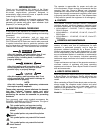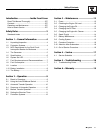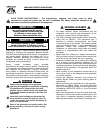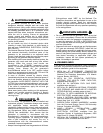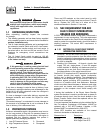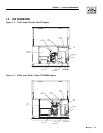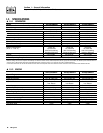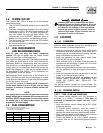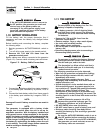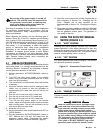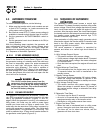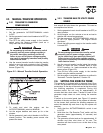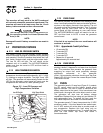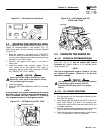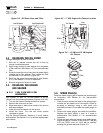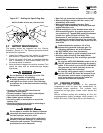
If the AUTO/OFF/MANUAL switch is not set to
its OFF position, the generator can crank and
start as soon as the battery cables are
connected. If the utility power supply is not
turned off, sparking can occur at the battery
posts and cause an explosion.
1.10 BATTERY INSTALLATION
Fill the battery with the proper electrolyte fluid if
necessary and have the battery fully charged before
installing it.
Before installing and connecting the battery, complete
the following steps:
1. Set the generator's AUTO/OFF/MANUAL switch to
OFF.
2. Turn off utility power supply to the transfer switch.
3. Remove the 7.5A and 15A fuses from the
generator control panel.
Battery cables were factory connected at the generator
(Figure 1.5). Connect cables to battery posts as follows:
Figure 1.5 – Battery Cable Connections
4. Connect the red battery cable (from starter contactor)
to the battery post indicated by a positive, POS or
(+).
5. Connect the black battery cable (from frame ground)
to the battery post indicated by a negative, NEG or
(—).
NOTE:
Damage will result if battery connections are made in
reverse.
NOTE:
The generator is equipped with a battery trickle
charger that is active when the unit is set up for
automatic operation. With the battery installed and
utility power source voltage available to the transfer
switch, the battery receives a trickle charge while the
engine is not running, to prevent self-discharge. The
trickle charger is designed to help extend the life of
the battery by maintaining the battery when the unit
is not running. The trickle charge feature cannot be
used to recharge a discharged battery.
1.11 THE BATTERY
Do not dispose of the battery in a fire. The
battery is capable of exploding.
A battery presents a risk of electrical shock
and high short circuit current. The following
precautions are to be observed when working
on batteries:
• Remove the 7.5A and 15A fuses from the
generator control panel.
• Remove watches, rings or other metal objects;
• Use tools with insulated handles;
• Wear rubber gloves and boots;
• Do not lay tools or metal parts on top of the
battery; and
• Disconnect charging source prior to connecting or
disconnecting battery terminals.
Do not open or mutilate the battery. Released
electrolyte has been known to be harmful to
the skin and eyes, and to be toxic.
The electrolyte is a dilute sulfuric acid that is
harmful to the skin and eyes. It is electrically
conductive and corrosive.
The following procedures are to be observed:
• Wear full eye protection and protective clothing;
• Where electrolyte contacts the skin, wash it off
immediately with water;
• Where electrolyte contacts the eyes, flush
thoroughly and immediately with water and seek
medical attention; and
• Spilled electrolyte is to be washed down with an
acid neutralizing agent. A common practice is to
use a solution of 1 pound (500 grams) bicarbonate
of soda to 1 gallon (4 liters) of water. The
bicarbonate of soda solution is to be added until
the evidence of reaction (foaming) has ceased. The
resulting liquid is to be flushed with water and the
area dried.
Lead-acid batteries present a risk of fire
because they generate hydrogen gas. The
following procedures are to be followed:
• DO NOT SMOKE when near the battery;
• DO NOT cause flame or spark in battery area; and
• Discharge static electricity from body before
touching the battery by first touching a grounded
metal surface.
Be sure the AUTO/OFF/MANUAL switch is set to
the OFF position before connecting the battery
cables. If the switch is set to AUTO or MANUAL,
the generator can crank and start as soon as
the battery cables are connected.
!
!
!
DANGER
Section 1 — General Information
Bryant Air-cooled 7 kW, 12 kW and 15 kW Generators
8 Bryant



